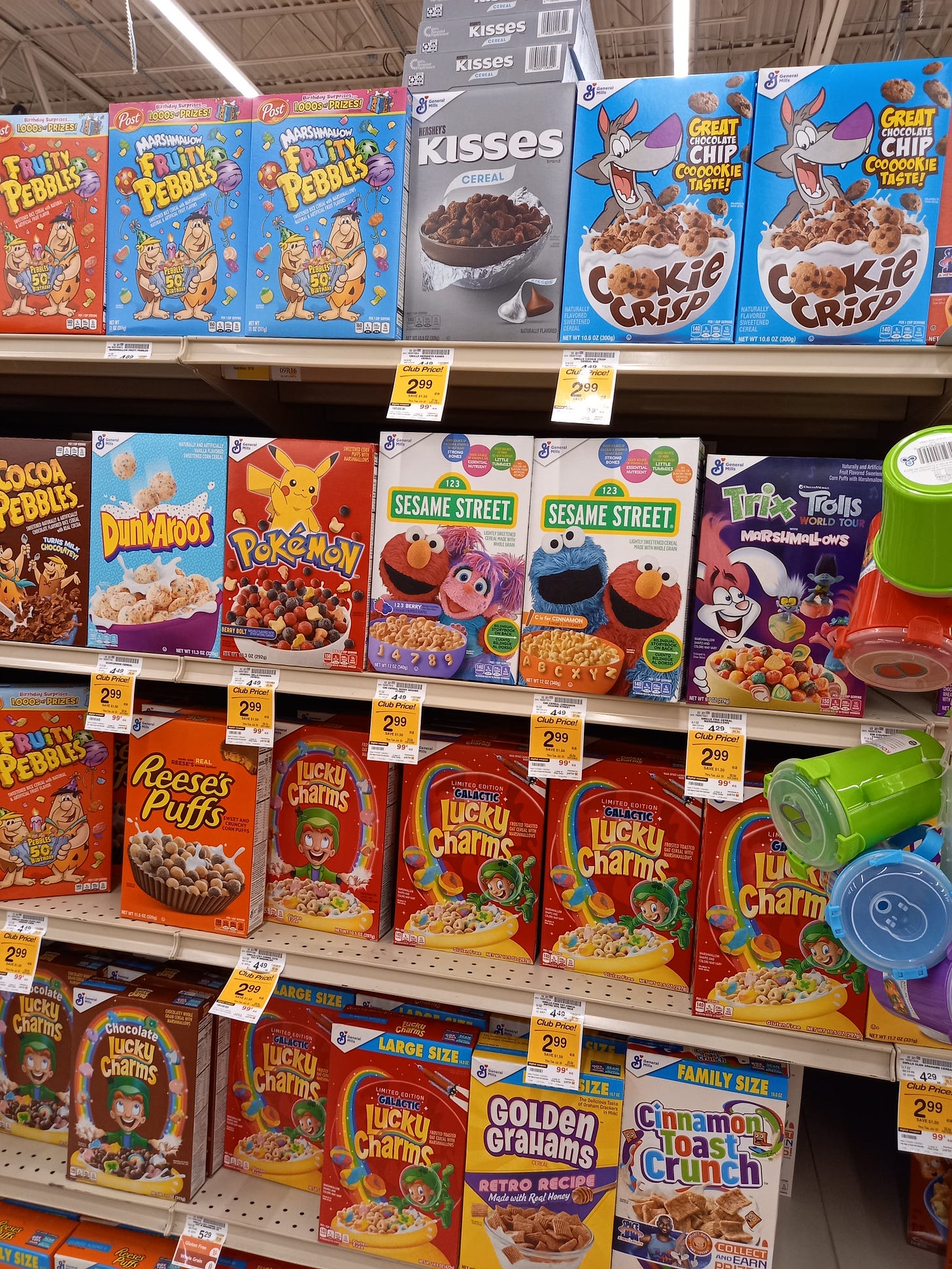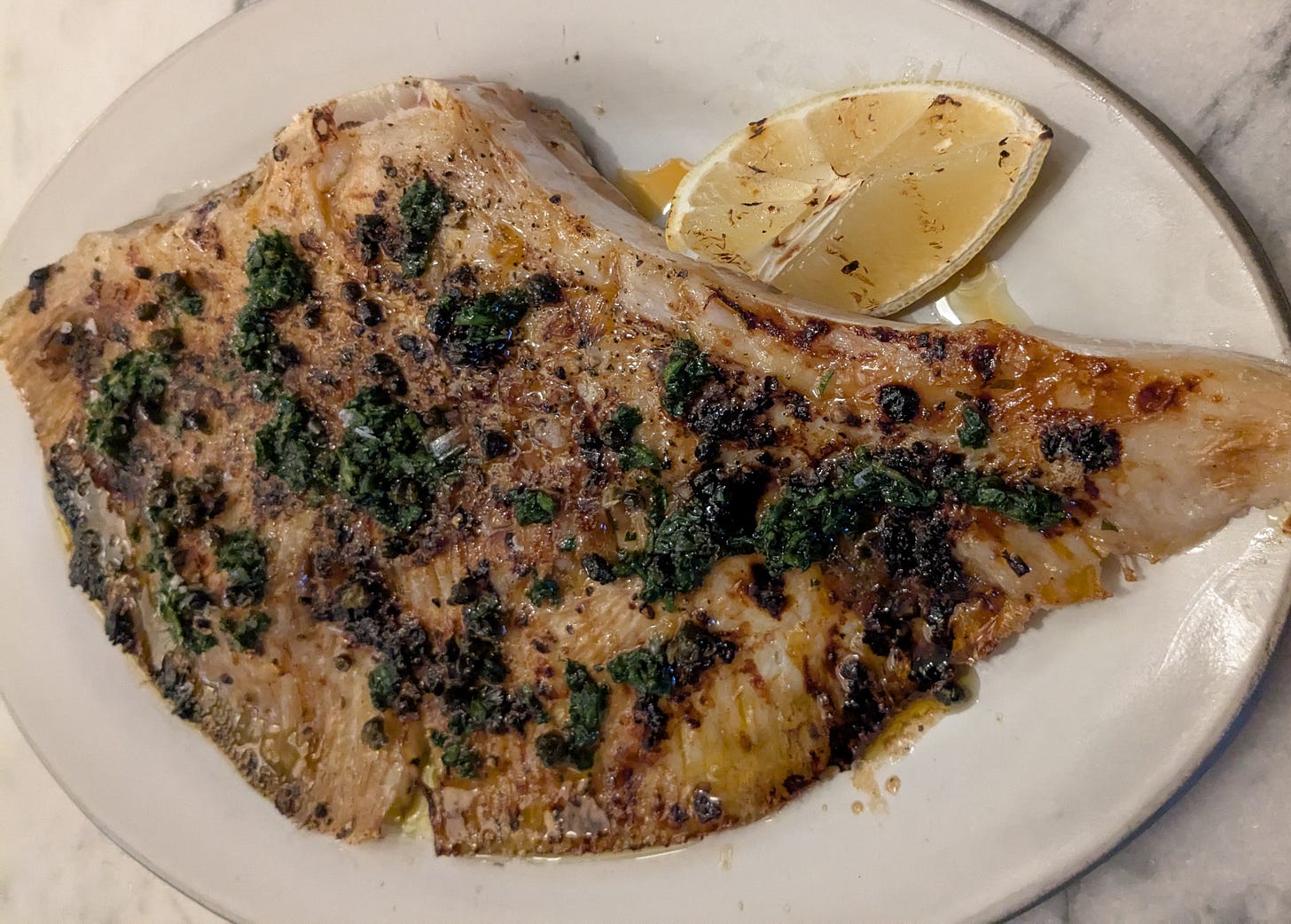Sickened by the colour of food?
A recipe for Skate wing with browned butter, capers and lemon

The first time I went food shopping in Washington DC, I came out of the resort-sized supermarket with 10 giant cans of tomatoes. I’d arrived from Moscow where tomatoes couldn’t be found for love nor rouble between the end of September and the beginning of June. Add to that the suspicion based on my Russian experience that the supermarket would have run out of them when I next came back and you’ll understand the purchase.
The whole shopping experience was daunting. Take milk. From cows alone there were four different kinds: whole fat, 2 percent, 1 percent and skimmed, plus the same in organic versions. Then there was A2 milk with beta-casein protein, as well as fortified milk, raw milk, and lactose-free. Oh, and chocolate and strawberry milk. I hadn't realised you could milk those. Back in Moscow, milk was either not available or curdled.
To partner these American milks, yards and yards of shelving were stacked with boxes of multi-coloured breakfast cereals.
Cereals? They contained more candies than processed grains. My children did what they could at school to solicit sleep-over invitations to friends’ houses so that in the morning they could hunch over their breakfast bowl ignoring the cereals and pick out the stiff pink, yellow, blue, green and orange marshmallow shapes. Unlike the favoured Lucky Charms, only slightly less popular boxes of super-sweetened Cinnamon Toast Crunch or Honey Nut Cheerios may not have included candies but an average serving delivered around 12 grams of sugar. They were spooned up dry without nourishing milk. Breakfast at our house was only plain Cornflakes or Grape Nuts or All Bran or toast and staying over with us not a popular option.
Child-magnets like Froot Loops and Trix are not the benign foodstuffs manufacturers would have you believe. To achieve their jolly colours, they are dependent on food colourants. The safety of these was questioned as far back as 1906, when Congress passed the Food and Drugs Act prohibiting the use of ‘deleterious’ colours in food, with one year later a list of just seven approved.
In 1927, responsibility for enforcing that Act was given to the newly established Food & Drugs Administration. Yet by 1931, as many as 15 colours had been approved for foods, six of them still in use in the US today.
Since 2008, Britain’s Food Standards Agency has put pressure on manufacturers to remove artificial food colourants completely, linking them to growing evidence of provoking ADHD in children. Where they haven't, any food and drinks containing specified artificial colourings must now state on the packaging “May have an adverse effect on activity and attention in children.” The EU has gone further, banning them outright.
It’s been enough to encourage food manufacturers to switch to natural sources for colouring, like turmeric (yellow), matcha (bright green), spirulina (greeny-blue), and beetroot (crimson) - which you may be interested to learn is going into next-trend cold brew coffee, Beetroot Latte Powder, and Pink Chai. Sigh.
At long last, synthetic food dyes in the US are to be phased out by 2028. The perhaps surprising champion of this initiative? Health & Human Services chief, Robert F Kennedy Jnr, who has removed Covid-19 booster shots from the recommended immunization schedule and last week threatened to ban US government scientists from publishing in “corrupt” medical journals like the New England Journal of Medicine and the Lancet.
“For too long, some food producers have been feeding Americans petroleum-based chemicals without their knowledge or consent,” he said. “These poisonous compounds offer no nutritional benefit and pose real, measurable dangers to our children’s health and development.”
It will be interesting to see how far the will of Congress bends to the politically powerful, hugely wealthy global industrial food complex. Britain’s timid government has been forced by manufacturers to back down on its previous determination to ban the promotion of highly profitable processed food. Money and political clout, not voters’ well-being, talks.
Colour affects the expectation and taste of what we put in our mouths. Professional wine tasters can become confused about whether they're drinking white or red when wines are served in black glasses. If the colour of a food is found appealing, a diner’s overall enjoyment will be increased, regardless of its flavour. Restaurateurs know that carefully calibrated ambient lighting shining down upon food can affect how much diners will eat.
Which makes the revival in Britain of beige food curious. Once notorious for its plates of tasteless concoctions, fashionable British restaurants have been serving up Instagram-able servings of beige cured mackerel served with apple; beige whole sea bass paired with beige fennel; beige croquettes; beige carpaccio of trout, and beige perfectly roasted chicken.
It surely confirms that if the flavour of a dish delivers impact, it’s this, not its colour, that makes a meal much relished.
Once, skate was thought of as a trash fish. Closely related to rays and sharks, only their wings are eaten. Their flesh is almost sweet, and their skeleton made of cartilage, so ideal for eaters fearful of bones.
Skate meunière is a French classic. If you can’t find skate, use any firm-fleshed white fish such as halibut, cod loin, or a sole for this recipe.
Serves 2
2 medium or 1 large skate wing, around 500g/1lb in weight
salt and freshly ground black pepper
1/2 cup flour spread on a dinner plate
2 tablespoons light oil, separated
5 to 6 tablespoons unsalted butter, in chunks
2 tablespoons capers, lightly chopped
juice of 1 lemon
1 heaped tablespoon finely chopped flat-leaf parsley
Season the skate with salt and pepper. Dredge it in flour on both sides, shaking off any excess.
Heat a frying pan over medium heat and melt together 1 tablespoon oil and 1 of butter. Add the skate to the pan and sauté for about 3 minutes, then carefully turn over with a wide spatula. Fry on the second side 2 minutes until just cooked through. Transfer to a large warmed serving plate.
Clean the frying pan and return to the heat. Stir the remaining butter over medium heat till the butter melts and browns, 3-4 minutes. Off the heat stir in the capers, then the lemon juice and return very briefly to the heat to warm back up. Spoon the sauce over the skate, sprinkle over the parsley and serve at once. With pureed potato if you like but it doesn’t really need a partner.





So much meat in this! You can add 'fish monger' to your already varied list of achievements? And at one of DC's better fish suppliers and restaurants? I raise my hat! I had regular arguments at Whole Foods with their fish mongers when I ask to sniff their fillets, and when not infrequently I caught a whiff of ammonia I'd asked for a cut from the fish not yet on display. They'd say they weren't allowed to put it out till everything out front had been sold. And I'd point out that would take long enough for the fresh stock to be past its prime. I've never come across skate sold filleted. It's more common in Europe and the UK for fish to be filleted only once the customer has picked their whole fish. If it's a turbot, the bones make the best, richest stock, a genuine bonus.
Skate is just about my favorite fish. It's a bit tricky to remove the cartilage before cooking, which may partly account for its unpopularity; these days, skate is almost always sold fileted in the US. When you can find it. It also has the advantage, due to its unpopularity, of being one of the cheapest choices in the fish case. But it goes bad quickly. It must be pearly pinkish and smell of the sea, and cooked the day it is bought. Having had experience, albeit brief, as a fish monger (at Black Salt, in DC) when I see skate in a fish case, I always ask: when did this come in? No more than two days in the case is acceptable. The answer 'today' or 'yesterday' is preferable. And then I ask to smell it. Any ethical fish monger, who isn't trying to pass off over-the-hill product should allow you to have a sniff--held out on a gloved had, or a piece of paper wrap. We used to tell customers who didn't know about skate, that 'it has a flavor and texture that is reminiscent of crabmeat.' Everyone in DC knows about crabmeat. I cook it the way you do, or shallow fried in a panko crust, served with a side of remoulade. Skate is caught in the Gulf of Maine, and there are seafood markets closely affiliated with local fishermen, where I have been able to find beautifully fresh skate filets, one of the many benefits of living here.